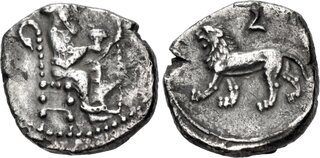| Classical Numismatic Group > Triton XXVII Online Sessions | Auction date: 17 January 2024 |
| Lot number: 5275 Price realized: 110 USD (Approx. 101 EUR) Note: Prices do not include buyer's fees. | Show similar lots on CoinArchives Find similar lots in upcoming auctions on |
| Lot description: CILICIA, Tarsos. Mazaios. Satrap of Cilicia, 361/0-334 BC. AR Obol (9.5mm, 0.72 g, 1h). Crowned figure of Artaxerxes III in the guise of Baaltars seated right, holding lotus flower and lotus-tipped scepter / Lion walking left; Z (in Phoenician[?]) above. Casabonne Series 6 and p. 218, n. 913; Göktürk –; SNG BN 425 (Myriandros). Lightly toned, small edge split, slight roughness. VF. From the Tiny Art Collection. The attribution of the walking-lion series of Mazaios had originally been given to the mint of Tarsos, but Newell argued that they more likely were struck at Myriandros in his study of that mint in AJN 53 (1919). Later, J.D. Bing, in AJN 1 (1989), argued for an alternative attribution of the Myriandros coinage to the mint of Issos. While most numismatic works continue to follow Newell, Casabonne's significant study of Cilicia during the Persian period convincingly returns these coins of Mazaios to the mint of Tarsos (cf. Casabonne, pp. 215–7). The appearance of Baaltars on this issue is significantly different from the relatively standard depiction of the deity on other coins of Tarsos. While the diety is typically shown nude to his waist, here the figure is fully clothed with attire that closely resembles that on the figure that appears on the royal Persian coinage struck at Sardes. More importanly, though, is the headdress on the figure. Baaltars typically wears a laurel wreath or no headdress, while this portrait shows the figure wearing an elaborate headdress. In a recent article, Frank Kovacs analysed the type, and argues that this figure is actually the Great King Araxeres III Ochos, in the guise of Baaltars, and the headdress is the combined crown of Upper and Lower Egypt, thus his appearance here is as pharaoh of Egypt (cf. F. Kovacs, "Two Persian Pharaonic Potraits" in JNG L [2000]; see also M. Thompson, in MN XII [1968], pp. 11–2, who notes the figure wearing a "high crown of Egyptian type"). This is plausible, as Araxerxes was the first pharaoh of the Thirty-First Dynasty of Egypt, and the date of his rule there, 343-338 BC, comports well with this issue under Mazaios. O. Casabonne, while acknowledging that the figure here may represent a synthesis of Baaltars and the Great King, disagrees with the identification of the headdress as the Egyptian crown. Instead, he views the headdress as being a Phrigian style cap that is often depicted in contemporary art as being worn by warriors (cf. Casabonne, p. 121, fig. 8), but is here shown with the cheek guards in a raised position. Nonetheless, it is doubless that the figure here is a synthesized portrait of Baaltars and the Persian Great King. The fractional silver of this issue, interestingly, may be most instructive, as the headdress on the figure is shown wearing a crown that is identical to that on the figure of the royal Achaemenid coinage and his robes have interlocking circles reminiscent of the darics of Carradice Type IV Late (cf. M. Thompson, op. cit., p. 12). Estimate: 150 USD |  |



